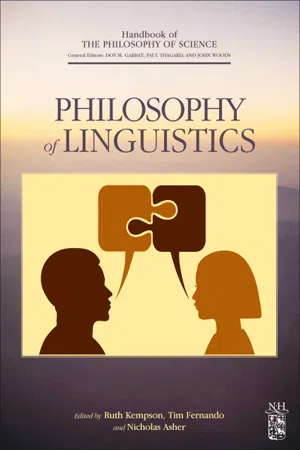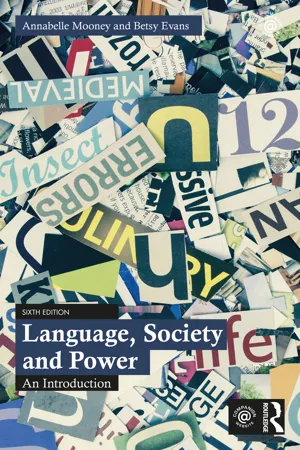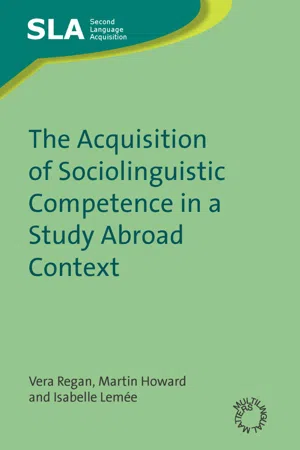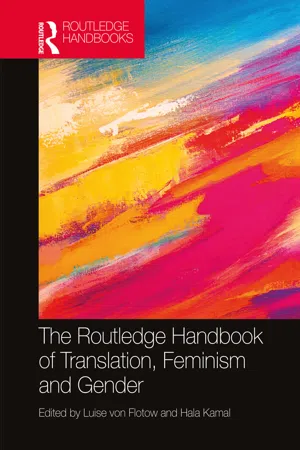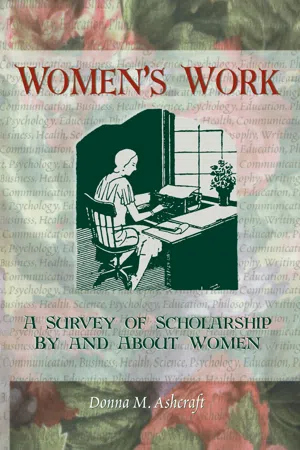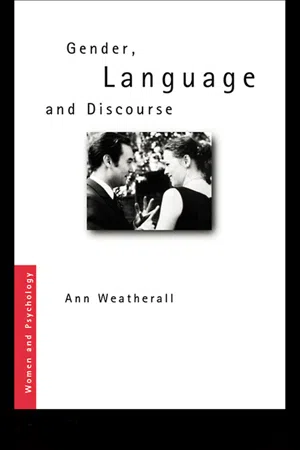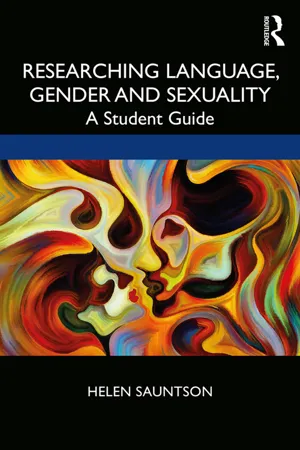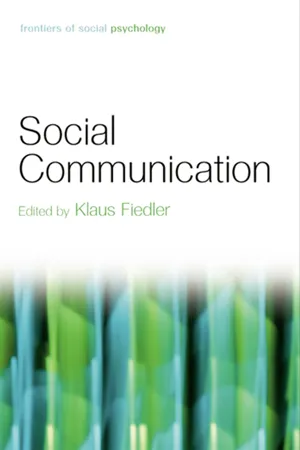Languages & Linguistics
Language and Gender
Language and gender refers to the study of how language and communication are influenced by gender differences. It explores how language can reflect and perpetuate gender stereotypes and power dynamics. This field examines various aspects of language, including vocabulary, grammar, and discourse, to understand how gender identity is constructed and maintained through linguistic practices.
Written by Perlego with AI-assistance
Related key terms
Related key terms
1 of 4
Related key terms
1 of 3
10 Key excerpts on "Language and Gender"
- eBook - ePub
- Dov M. Gabbay, Paul Thagard, John Woods(Authors)
- 2012(Publication Date)
- North Holland(Publisher)
How are gendered and sexualized individual and social identities constructed and changed? How are biology and social life intertwined in these processes? What kinds of diversity do we find among those who claim or are ascribed the same gender or the same sexual orientation? How do gender and sexuality interact with class, race, religion, economic status, age, nationality, and other dimensions of social difference? How do they enter into social and power relations? How do they relate to cultural ideologies and values, to default assumptions about ourselves and others? What moral issues are raised? Such questions are central to gender studies. Their answers involve many complex factors far beyond the realm of linguistics, but there are nearly always also significant matters of language and its use involved.Gender studies raises many challenging questions about language and about linguistic inquiry.• Which identities does language index and how? • Where do linguistic diversity and language change fit in a model of language as part of universal human biological endowment? • How well can speech acts be understood in individualistic terms? • How can available linguistic resources affect individual cognition and joint social pursuits? • How are linguistic forms invested with semantic content? With other kinds of communicative significance? • How and why do substantive conflicts of interest sometimes play out as 'mere' disputes over meaning?While not organized around these questions, this chapter explores some of the research on language, gender, and sexuality that have stimulated my own thinking about them.1 Indexing Identities
When linguists first began thinking about gender issues in the early 1970s, the focus was on what was then called women's studies. Linguists began exploring two main topics. One was so-called ‘women's language’ — ways of speaking supposed to be distinctively ‘feminine’, patterns that indicated or INDEXED identity as a woman. The other was ways of speaking about women — e.g., what were described as ‘euphemisms’ like lady and ‘dysphemisms’ like broad. American linguist Robin Lakoff [1975] offered this division into speaking by and speaking of and made a number of impressionistic claims that others sought to test more systematically.1 - eBook - ePub
Language, Society and Power
An Introduction
- Annabelle Mooney, Betsy Evans(Authors)
- 2023(Publication Date)
- Routledge(Publisher)
CHAPTER 6 Language and GenderDOI: 10.4324/9781003120957-6CONTENTS
6.1 INTRODUCTION6.2 WHAT IS GENDER?6.3 INEQUALITY AT THE LEXICAL LEVEL6.4 DIFFERENCES IN LANGUAGE USE: DOING BEING A ‘WOMAN’ OR A ‘MAN’6.5 GOSSIP6.6 GENDER AND POWER6.7 GENDERED TALK: PERFORMING IDENTITY6.8 SUMMARY6.1 INTRODUCTION
In this chapter, we examine Language and Gender. We begin by considering the meaning of ‘gender’ by contrasting it with ‘sex’. We then turn to issues of hierarchies of gender groups in language. We explore the use of lexical items that represent women less favourably than men as an example of inequality. We then explore pronouns as a way of showing the complexity of sex, gender, and power. We then look at different kinds of talk, including the form of communication known as gossip, in order to evaluate whether and how men and women use language differently. To examine the language of more deeply entrenched ideologies associated with gender, we then consider whether women talk more than men. Finally, we investigate how gender identity is performed through language and the connection between gender and sexuality.6.2 WHAT IS GENDER?
There is a strong relationship between Language and Gender in terms of how language is used and how it is understood. In order to explore these relationships, there are a few key things to remember as you read this chapter. Firstly, we must establish what we mean by ‘sex’ and ‘gender’. In the past, many linguists used the term ‘sex’ rather than ‘gender’ in research about language. In the first wave of linguistic studies of variation, academics were usually interested in broad patterns across a large population. In this context, it can make sense to divide people according to their sex. This was also a time when ‘gender’ was not understood in the way it is now. However, other models developed to explain the linguistic differences found among individuals, and this culminated in a recognition that sex is not always the best category of analysis. For some time, it was considered that sex is biological while gender is socially constructed. However, it is important to remember that biological sex is also not straightforward (Ansara and Hegarty, 2013 ; Lindström, Näslund, and Rubertsson, 2015 .) We tend to think that someone’s biological sex is a simple scientific fact. But this is far from true. In this chapter, we begin by orienting to a binary sex distinction in order to draw out the difference between sex and gender. In Section 6.3.3 - Vera Regan, Martin Howard, Isabelle Lemée(Authors)
- 2009(Publication Date)
- Multilingual Matters(Publisher)
This is what defines our social identity and our gender, not simply physical or biological characteristics. Gender can no longer be adequately analysed as a simple dichotomy, but as ‘the accomplishment and product of social interaction. Language is a resource which can be drawn on creatively to perform different aspects of one’s social identity at different points in an interaction’ (Holmes & Meyerhoff, 2003: 11). Gender is something you ‘do’ or perform. 4 Gender and L2 Acquisition As we have seen, a considerable amount of research in recent years has been done on how speakers use linguistic variants to express gendered identities in different contexts in native speaker speech. Keeping in mind the important body of recent research (Coates, 1993; Ehrlich, 2001; Holmes, 1994, 1995, 1997, 1998; Mendoza-Denton, 2004) which cogently demonstrated the dangers and limitations of an overly simplistic interpretation of the category of sex in investigations of the role of gender in language, there is nevertheless much evidence that speakers use language to mark their gender in different contexts or types of talk (Freed, 1996). People make linguistic choices and even seem to be aware from a very early age that language behaviour is gendered. In relation to L1 acquisition, variationist studies have found that children, even at a very young age, seem to be conscious of and are capable of adopting the gendered variation patterns of the context in which they find themselves. For instance Roberts and Labov (1995) and Roberts (1997) found that American English-speaking children as young as three years old were using the adult speech patterns in relation to t/d deletion and in/ing variation- Luise von Flotow, Hala Kamal, Luise von Flotow, Hala Kamal(Authors)
- 2020(Publication Date)
- Routledge(Publisher)
é criture inclusive” which promotes changes in the orthography of French (Haddad 2017, 5). Language generally “resists” any imposed change, but such initiatives are evidence of an open debate which cannot be ignored: all over the Anglo-American/European world, professionals working in a plurilingual dimension are having to make choices related to gender agreement on the basis of sociocultural contextual features. In this contemporary and multilingual environment most speakers know more than one language. In some cases, bilingual speakers operate between languages with different gender systems, which doubtless increases their awareness of sex and gender as language categories.- 3 Therefore, investigations from the perspective of bilingualism could complement research work on translation and gender seen as an abstract system of language. This is already the case with a number of studies on the “gender interference effect” of L1 on L2 in the field of picture naming and comprehension tasks when the gender of nouns or noun phrases do not match (see Bordag 2004; Bordag and Pechmann 2007 and the unpublished works quoted therein). Further studies (Bordag and Pechmann 2008) illustrate, however, that interference factors affecting gender retrieval are not present in the field of translation thus advocating the need for further experiments on processes occurring when moving from one language to another. Extensive future investigation is thus required in this field through an interdisciplinary lens.
Related Topics
Feminist translation, gender and language, translation and gender, feminist linguistics, gender and grammar, intersemiotic translation, morphology and semantics.Further readings
Hellinger, Marlis and Hadumod Bußmann, eds. 2001/2002/2003. Gender Across Languages: The Linguistic Representation of Women and Men, vol. 1, 2, 3. Amsterdam: Johns Benjamins.Hellinger, Marlis and Heiko Motschembacher, eds. 2015. Gender Across Languages: The Linguistic Representation of Women and Men, vol. 4. Amsterdam: Johns Benjamins.This four-volume reference work (the first three published between 2001 and 2003, and a fourth volume added in 2015) provides systematic descriptions of various categories of gender (grammatical, lexical, referential, social) in 42 languages of diverse genetic, typological, and sociocultural backgrounds.Corbett, Greville G., ed. 2014. The Expression of Gender. Berlin and Boston: De Gruyter Mouton.An edited volume by an expert and prolific author in the field of gender which shows the many different perspectives of this issue, from the morphosyntactic to the psycholinguistic; from the main to minority languages.- eBook - ePub
Women's Work
A Survey of Scholarship By and About Women
- Ellen Cole, Esther D Rothblum, Donna M Ashcraft(Authors)
- 2013(Publication Date)
- Routledge(Publisher)
Chapter 12 Gender and Communication: The Influence of Gender on Language and Communication Myrna Foster-KuehnThe latest buzz on sex differences, the hottest development in the debate on homemaking versus careerism, or the newest take on how to resolve confusion over interpersonal relationships between women and men seems to be waiting on the next headline or talk show lineup. Issues dividing women and men hold a perpetual interest for us. And why not? Our gender and our need to communicate with others are inescapable facts of life. Gender communication is the fabric of our daily lives. But what exactly is gender communication?A simple answer would be that studying gender and communication is learning about how women and men talk differently? But when we take a closer look at that basic idea, things get more complicated. The answer is not as easy as it would seem. Some say that not all communication is gender communication (Ivy and Backlund, 1994 ), while others believe that communication cannot escape the effects of gender and therefore all communication is "gendered" (Schaef, 1981 ; Thorne, Kramarae, and Henley, 1983 ; Spender and Kegan, 1985). Although gender and sex are sometimes used interchangeably, the two concepts have very distinct meanings.Once you begin learning about gender and communication, it readily becomes apparent that gender is more than simple biological classifications, and communication is more than just talk. This chapter provides an overview of the various approaches to understanding "gender and communication" by examining the definitions of gender and communication, the social construction of gender communication, how the language usage of women and men reflects and shapes our daily interactions, and how anyone can become a more competent communicator.Defining Gender and Communication
Sex and Gender
Most of us have very little difficulty filling out forms that ask us to indicate our sex. Our choices are naturally simple: male or female. Sex is a designation based on biology. We use genetic and biological qualities to define whether a person is female or male. Each of us is labeled at birth based on observable physical evidence, that is, the nature of the genitalia. We assume that, except in very extreme cases, most individuals are clearly one sex or the other and will grow and develop accordingly. Our daily interactions are not as clear-cut, however. How often do parents carefully pick the "right" color baby clothes for their newborn to avoid those awkward social moments? The Saturday Night Live - eBook - ePub
- Ann Weatherall(Author)
- 2005(Publication Date)
- Routledge(Publisher)
6: LANGUAGE, DISCOURSE AND GENDER IDENTITY
Introduction
The topic of gender identity and issues concerning its relationship to language and discourse have been mentioned at several points in this book so far. An important point was made in Chapter 4 , when I described the discursive turn as being characterised by a theoretical shift in the conceptualisation of identity. That change was from a notion of gender identity as existing prior to language, to the idea of gender identity being discursively constituted. However, up until now I have discussed identity largely as it has been relevant to other issues, such as why definitive answers to questions of gender difference in language use have not been found, and the similarities amongst different explanations of ‘women’s language’. The purpose of this chapter is to explore more thoroughly the topic of language, discourse and gender identity.This chapter will begin with a discussion of a more traditional strand of research based on essentialist and realist assumptions about gender identity - essentialist in the sense that gender identity is seen to be a property of individuals and society, and realist because it is assumed that there is some kind of correspondence between individuals’ gender identities and the way gender is manifest in the organisation and structure of society. Following these assumptions, gender identity is understood as an internalisation (through socialisation and social learning) of the gendered organisation of society. Thus, conventionally within psychology, gender identity has been viewed as an internal, stable and coherent psychological characteristic of the individual that motivates, amongst other behaviours, speech style.Research following a conventional psychological approach has investigated language use as a site where gender identity is expressed. A (questionable) distinction made by such research is between ‘real’ sex markers of speech (linguistic features that truly differentiate between women and men) and speech sex stereotypes (beliefs about the features associated with each gender regardless of actual use) (Smith, 1979). A key point here is that the conceptual distinction between ‘real’ and ‘stereotyped’ gender differences in speech is problematic. Differences between women’s and men’s speech may well exist, but what differentiates women’s speech from men’s cannot be reduced to a set of simple (or even complex) features. To use the Ochian phrase, few features of language directly and exclusively index gender (Ochs, 1992). - eBook - ePub
Researching Language, Gender and Sexuality
A Student Guide
- Helen Sauntson(Author)
- 2019(Publication Date)
- Routledge(Publisher)
Cameron (2005) notes that the study of Language and Gender started to give greater prominence to sexuality throughout the 2000s which increasingly incorporated considerations of ‘queer’ gender identities and explorations of the relationship between gender and heteronormativity. In linguistics, work by Cameron (1997), Coates (2007), Leap (1996), Morrish and Sauntson (2007, 2010), Motschenbacher (2011) and others has shown that the semiotic resources associated with gender categories are deployed as a means of constructing sexual identities in and through discourse. Gender and sexual identity cannot be separated as the construction of both identities tends to rely on the same discursive resources. Such work suggests that there is a clear relationship between gender and sexuality, that the two are not experienced separately and that they cannot be separated for the purpose of analysis.Contemporary approaches to gender and language question the assumption that language merely reflects gender and sexuality. Rather than language simply reflecting gender differences, current research views gender (and, now, sexuality as well) as being discursively constructed through language. We will consider this idea, along with other current theoretical and conceptual approaches in the field, in Chapter 2 . For now, the remainder of this introductory chapter will elaborate on the central problem of all earlier approaches – why it is problematic to focus on ‘gender difference’ in research – as well as introducing some other key concepts in the field.Problems with ‘gender difference’
As stated earlier, early approaches to Language and Gender (sexuality did not appear until later) tended to focus on identifying ‘gender differences’ in language, for example, how women and men talk differently. Despite these early approaches receiving so much critical attention, Sunderland (2014) states that looking for alternative work on similarities across women/men and girls/boys is not easy. This, she argues, is because there is still a dominant, probably universal, discourse of ‘gender difference’ which pervades non-academic contexts. This discourse is easily and broadly appealing, and its popularity is evidenced through the high sales of best-selling books, such as John Gray’s Men Are From Mars, Women Are From Venus (2002);1 Pease and Pease’s Why Men Don’t Listen and Women Can’t Read Maps(2001); and Deborah Tannen’s You Just Don’t Understand: Women and Men in Conversation(1992).2 - eBook - ePub
- Ruth Wodak, Ruth Wodak(Authors)
- 1997(Publication Date)
- SAGE Publications Ltd(Publisher)
It is conceivable that the much-vaunted postmodem ‘fluidity’ of gender boundaries may function, at the level Susan Gal calls Ideological-symbolic’, to cement particular cultural constructions of gender even more firmly in place. ‘Fluidity’ means that individual subjects are given licence to cross previously forbidden boundaries; but the gendered meanings and identity choices on offer either side of the line are not at all ‘fluid’; on the contrary, they are arguably becoming fossilized in their most exaggerated and dichotomous forms. This may indeed mark a change in the historical forms of gender relations, but from some feminist perspectives it is not obviously a change for the better.What is interesting (and perhaps alarming) from the perspective of feminist linguistics, however, is the increasingly prominent and selfconscious role which the manipulation of language seems to be playing in this process. There is a massive irony in the use of linguistic descriptions whose aim was to critique current forms of femininity for the purpose of codifying ‘women’s language’ so that individuals such as drag artists and transsexuals can train themselves to be more ‘authentic’ women! There could hardly be a more pointed demonstration of the dangers, for feminists, of uncritically embracing the ideology of linguistic descriptivism.The complexity of practice: is it gender, really?
In the abstract of a now-classic article titled ‘The whole woman’, Penelope Eckert addressed her colleagues in the quantitative paradigm of sociolinguistics as follows:Speaker’s sex has emerged as one of the most important social factors in the quantitative study of phonological variation. However, sex does not have a uniform effect on variables … This is because sex is not directly related to linguistic behavior but reflects complex social practice. The correlations of sex with linguistic variables are only a reflection of the effects on linguistic behavior of gender … However, because gender differences involve differences in orientation to other social categories, the effects of gender on linguistic behavior can show up in differences within sex groupings. (1989: 245, emphasis added)Eckert does not merely castigate those linguists for whom the division of a sample into ‘men’ and ‘women’ is taken as a self-evident and sufficient basis on which to generalize about sex or gender differences. More provocatively, she suggests that the effects of gender may show up in behavioural differences between - eBook - ePub
Language, Gender, and Sexuality
An Introduction
- Scott F. Kiesling(Author)
- 2019(Publication Date)
- Routledge(Publisher)
Chapter 4 How we got here A brief history of the study of language, gender, and sexuality Noticing that gender is in language and that how a person speaks is related to their gender identity is not new. Linguists (and no doubt others) have long noted situations in which gender is related to language. For example, in 1958, John Fischer published a study of school children and how they pronounce words ending in -ing in English: for example, working or workin’ (in the International Phonetic Alphabet [IPA] of my pronunciation, [wɚkɪŋ] vs. [wɚkɪn]). This early study only had a few participants but found a difference in the rates of the boys’ and girls’ use of the alternation, with the girls using more - ing than the boys. Interestingly, the biggest difference found was between a boy he identified as a “model boy” and the other “typical boys,” with the typical boys using more of the -in variant. So, by 1958, linguists had already started to perform studies on how gender affects language use. Even earlier, linguists had also found a few cultures in which different ‘rules for speaking’ were expected depending on gender, among other social categories relevant in each culture. An early example of this was a study of the Koasati people by Mary Haas in 1944. 1 Koasati is a Native American Language spoken by approximately 200 people in Louisiana, USA (although when Haas was working there were no doubt many more speakers). Haas reported that for certain morphemes, men use a different pronunciation than women. Haas documented six different sets of rules for this difference, but the majority involve a change of consonants to [s] or an addition of [s]. Haas went on to mention that these differences are well known to the speakers, to the point that they are used in telling stories even when the gender of the speaker is not the same as that of the character (that is, if a man tells a story and a he quotes a woman, he uses the ‘women’s language’) - eBook - ePub
- Klaus Fiedler(Author)
- 2011(Publication Date)
- Psychology Press(Publisher)
At closer inspection it becomes evident that the linguistic representation of the sexes is never restricted to a mere distinction of female versus male. Instead, the linguistic structures concerned are characterized by asymmetries which communicate evaluations and stereotypes, for the way female and male persons are referred to in a language is affected by the “gender belief system” prevalent in the speech community. In turn, linguistic structures contribute to the construction and maintenance of this belief system. The question of how the sexes are represented in language is therefore not only of linguistic interest but constitutes a transdisciplinary field of research where linguistic aspects intersect with psychological and sociological issues.It is the aim of the present contribution to give an overview of how the sexes are “dealt with” in language(s) and of the consequences that result from this linguistic treatment. Our main focus will be the issue that is central to the discussion on language and sex – masculine generics and the question of sexist versus non-sexist language – but we will also address more general aspects. Firstly we will describe how sex is expressed in grammatical gender languages, natural gender languages, and genderless languages and will raise the question whether the different structures can be considered sexist. Then we will summarize the discussion about feminist language critique, followed by an overview of the empirical research on the effects that masculine and alternative generics have on hearers or readers: Here we refer to investigations on English, as representative of natural gender languages, and on German, representative of grammatical gender languages. As the problem of masculine generics does not concern genderless languages to the same extent, they will not be discussed here. Questions associated with feminist language reform, such as the acceptance of gender-fair language and the changes induced by feminist language critique, are presented and, finally, our conclusions.
Index pages curate the most relevant extracts from our library of academic textbooks. They’ve been created using an in-house natural language model (NLM), each adding context and meaning to key research topics.
Explore more topic indexes
Explore more topic indexes
1 of 6
Explore more topic indexes
1 of 4
